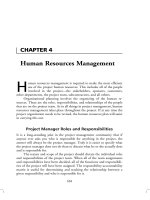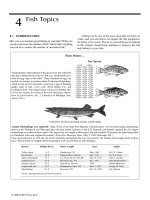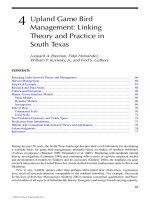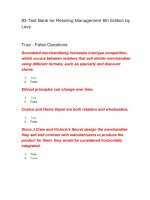Lecture Retailing management (6/e): Chapter 4 - Levy Weitz
Bạn đang xem bản rút gọn của tài liệu. Xem và tải ngay bản đầy đủ của tài liệu tại đây (1.67 MB, 44 trang )
Chapter 4
Customer Buying Behavior
McGrawHill/Irwin
Retailing Management, 6/e
Copyright © 2007 by The McGrawHill Companies, Inc. All rights reserved.
Illustration of Buying Process
Jennifer Sanchez, at San Francisco
State University, is beginning to
interview for jobs. For the first
interviews on campus, Jennifer had
planned to wear the blue suit her
parents bought her three years ago.
But looking at her suit, she realizes
that it’s not very stylish and that the
jacket is beginning to show signs of
wear. Wanting to make a good first
impression during her interview, she
decides to buy a new suit.
4-2
Andrew Ward/Life File/Getty Images
4-3
Illustration (Continued)
Jennifer surfs the Internet for tips on dressing for
interviews (www.collegegrad.com and
www.jobsearch.about.com) and looks through some
catalogs to see the styles being offered. But she decides
to go to retail store so she can try it on and have it for her
first interview next week. She likes to shop at
Abercrombie and Fitch and American Eagle Outfitter, but
neither sells business suits. She remembers an ad in the
San Francisco Chronicle for women’s suits at Macy’s.
She decides to go to Macy’s in the mall close to her
apartment and asks her friend Brenda to come along.
Jennifer values Brenda’s opinion, because Brenda is
interested in fashion.
4-4
Illustration (Continued)
Walking through the store,
they see some DKNY suits.
Jennifer looks at them briefly
and decides they’re too
expensive for her budget
and too stylish. She wants to
interview with banks and
thinks she needs a more
conservative suit.
John A. Rizzo/Getty Images
Illustration (Continued)
Jennifer and Brenda are approached by a
salesperson in the career women’s department.
After asking Jennifer what type of suit she wants
and her size, the salesperson shows her three
suits. Jennifer asks Brenda what she thinks about
the suits and then selects one to try on. When
Jennifer comes out of the dressing room, she
feels that the shoulder pads in the suit make her
look too heavy, but Brenda and the salesperson
think the suit is attractive. Jennifer decides to buy
the suit after another customer in the store tells
her she looks very professional in the suit.
4-5
Illustration (Continued)
Jennifer doesn’t have a Macy’s charge card, so
she asks if she can pay with a personal check.
The salesperson says yes, but the store also
takes VISA and MasterCard. Jennifer decides
to pay with her VISA card.
As the salesperson walks with Jennifer and
Brenda to the cash register, they pass a display
of scarves. The salesperson stops, picks up a
scarf, and shows Jennifer how well the scarf
complements the suit. Jennifer decides to buy
the scarf also.
4-6
Stages in the Buying Process
4-7
4-8
Types of Needs
• Utilitarian Needs –satisfied when purchases
accomplish a specific task. Shopping needs to
be easy and effortless like Sam’s or a grocery
store.
• Hedonic needs – satisfied when purchases
accomplish a need for entertainment, emotional
and recreational experience as in department
stores or specialty stores.
4-9
Satisfied Hedonic Needs
Stimulation
Social experience
Learn new trends and fashions
Satisfy need for power and status
Self-rewards
Adventure
Stimulating Need Recognition
410
Suggestions by Sales Associates
Advertising and Direct Mail
Visual Merchandise in store
Special Events in the Store
Signage
Displays
Stockbyte/Punchstock Images
411
Factors Affecting Amount of Information Search
Nature of the Product
Complexity
Cost
Characteristics of Customer
Past experience
Perceived risk
Time pressure
Aspects of the Market
Number of alternative brands
Sources of Information
412
Internal
Past experiences
Memory
Digital Vision / Getty Images
External
Consumer reports
Advertising
Word of mouth
The McGraw-Hill Companies, Inc./John Flournoy, photographer
413
How Can Retailers Limit the Information Search?
Information from sales associates
Provide an assortment of services
Provide good assortments
Everyday low pricing
Credit
Royalty-Free/CORBIS
Providing Information on Internet
Buying a Car On-line
(c) image100/PunchStock
414
Characteristics About Food Retailers
415
Evaluation of Retailers
416
Info Sanchez Used in Buying Suit
417
Information Needed to Use MultiAttribute Model
• Alternative retailers consumers can
consider
• Characteristic/Benefits Sought in Making
Store and Merchandise Choices
• Ratings of Alternative Performance on
Criteria
• Importance weights that consumers
attach to the merchandise
418
419
Getting into the Consideration Set
• Increase Performance Beliefs of Your
Store
• Decrease Performance Beliefs About
Competitor
• Increase Importance Weight of Attributes
on which You Have an Advantage
• Add a New Benefit on which You Excel
420
Purchasing Merchandise or Services
Customers do not always purchase a brand with the
highest overall evaluation.
The McGraw-Hill Companies, Inc./Jill Braaten, photographer
• The high-rated item may
not be available in the
store.
• How can a retailer increase
the chances that customers
will convert their
merchandise evaluations
into purchases?
Converting Merchandise or Services
Evaluations into Purchases
The McGraw-Hill Companies, Inc./Andrew Resek, photographer
• Don’t stock out of popular
merchandise
• Offer liberal return policies, money
back guarantees, and refunds if
same merchandise is available at
lower prices from another retailer
• Offer credit
• Make purchases easy by having
convenient checkout
• Reduce waiting times at checkout
421
422
Adam Crowley/Getty Images
Types of Purchase Decisions
Extended Problem Solving
Janis Christie/Getty Images
-High financial or Social Risk
Limited Problem Solving
Habitual Decision Making
-Store Brand, Loyalty
Greg Kuchik/Getty Images
-Some Prior Buying Experience
Extended Problem Solving
423
Consumers devote time and effort analyzing alternatives
• Financial risks – purchasing expensive products or services
• Physical risks – purchases that will affect consumer’s health
and safety
• Social risks – consumers will believe product will affect how
others view them
What Retailers Need to do for Customers Engaged in
424
Extended Problem Solving
Provide a Lot Information
-Use Salespeople rather than advertising to
communication
with customers
Reduce the Risks
-Offer Guarantees
-Return Privileges
© Royalty-Free/CORBIS
Limited Problem Solving
425
Purchase decisions process involving moderate amount of effort and time
• Customers engage in this
when they have had prior
experience with products or
services
• Customers rely more on
personal knowledge
• Majority of customer
decisions involve limited
problem solving
(c) Brand X Pictures/PunchStock









